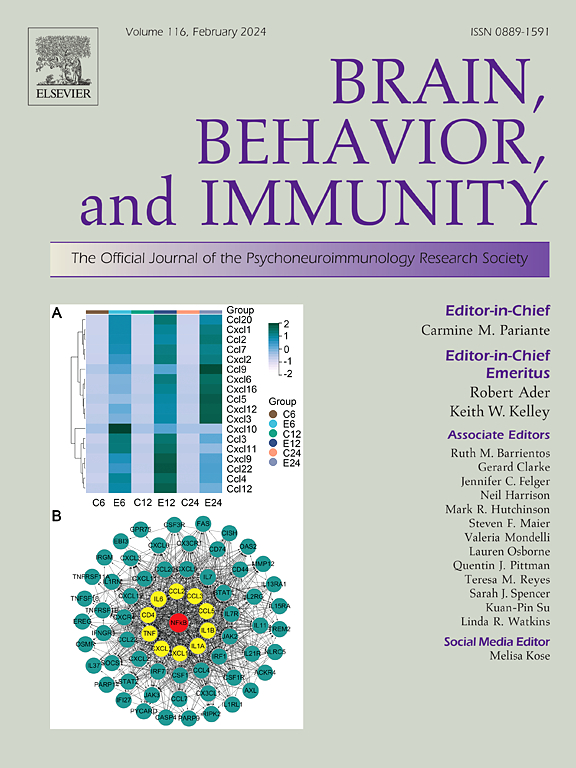Peripartum buprenorphine and oxycodone exposure impair maternal behavior and increase neuroinflammation in new mother rats
IF 8.8
2区 医学
Q1 IMMUNOLOGY
引用次数: 0
Abstract
7 % of pregnant people use opioids. Opioid use during pregnancy can negatively impact maternal and offspring health. Medications for opioid use disorder (MOUD), commonly buprenorphine, are the recommended treatment for opioid use disorder during pregnancy to prevent cycles of withdrawal and relapse. In addition to effects on opioid receptors, opioids have strong binding affinity to toll-like receptor (TLR) 4, an immune cell receptor, and thereby impact neuroinflammatory signaling. We have previously shown that neuroimmune alterations are important for the display of maternal behavior. Here, we used a rodent model to assess the impact of chronic peripartum opioid exposure or MOUD on maternal caregiving and neuroinflammation in the postpartum brain. Female rats were exposed to vehicle (VEH), buprenorphine (BUP) to model MOUD, or oxycodone (OXY), to model peripartum drug use, before, during, and after pregnancy. Opioid exposure reduced gestation length and maternal weight gain. Postpartum maternal caretaking behaviors, including pup retrieval, huddling and nursing, and pup-directed sniffing and licking, were reduced in opioid-exposed mothers. Following behavioral testing, tissue was collected from brain regions important for maternal caretaking, including the prefrontal cortex (PFC), nucleus accumbens (NAc), preoptic area (POA), amygdala (AMY), and periaqueductal grey (PAG). Immunofluorescent labeling showed that BUP increased astrocyte labeling, while OXY increased microglia labeling in the PAG, but not other regions. Gene expression analysis also showed regional and treatment differences in immune transcripts. BUP and OXY increased TLR4 in the PFC. BUP increased TNF in the NAc but decreased IL1β in the POA. OXY increased CD68 in the POA, and IL1β, TNF, and TLR4 in the PAG. Together, these results provide novel evidence of peripartum neuroimmune alterations following chronic opioid exposure that could be mediating maternal care deficits. This work provides a foundation to explore the extent to which modulation of neuroimmune activation may be a potential intervention for caregiving deficits in mothers exposed to opioids during pregnancy.
围产期丁丙诺啡和羟考酮暴露损害母性行为,增加新母鼠大脑神经炎症。
7%的孕妇使用阿片类药物。怀孕期间使用阿片类药物会对孕产妇和后代健康产生负面影响。阿片类药物使用障碍(mod)的药物,通常是丁丙诺啡,是怀孕期间阿片类药物使用障碍的推荐治疗方法,以防止戒断和复发周期。除了对阿片受体的作用外,阿片样物质与toll样受体(TLR) 4(一种免疫细胞受体)有很强的结合亲和力,从而影响神经炎症信号。我们之前已经表明,神经免疫改变对母性行为的表现很重要。在这里,我们使用啮齿动物模型来评估慢性围产期阿片类药物暴露或mod对产妇护理和产后大脑神经炎症的影响。雌性大鼠在怀孕前、怀孕期间和怀孕后分别暴露于载药(VEH)、丁丙诺啡(BUP)或羟考酮(OXY)。阿片类药物暴露减少妊娠期长度和母亲体重增加。暴露于阿片类药物的母亲的产后照顾行为,包括幼犬的取回、依偎和哺乳,以及幼犬导向的嗅探和舔舐,都有所减少。在行为测试之后,收集了对母亲照顾重要的大脑区域的组织,包括前额叶皮层(PFC)、伏隔核(NAc)、视前区(POA)和导水管周围灰质(PAG)。免疫荧光标记显示BUP增加星形胶质细胞标记,而OXY增加PAG的小胶质细胞标记,而其他区域没有。基因表达分析也显示了免疫转录物的区域和治疗差异。BUP和OXY使pfc中TLR4升高,NAc中TNF升高,POA中il - 1β降低。OXY增加POA中的CD68, PAG中的il - 1β、TNF和TLR4。总之,这些结果提供了新的证据围产期神经免疫改变后慢性阿片类药物暴露可能介导产妇护理缺陷。这项工作为探索在多大程度上调节神经免疫激活可能是怀孕期间暴露于阿片类药物的母亲的潜在干预措施提供了基础。
本文章由计算机程序翻译,如有差异,请以英文原文为准。
求助全文
约1分钟内获得全文
求助全文
来源期刊
CiteScore
29.60
自引率
2.00%
发文量
290
审稿时长
28 days
期刊介绍:
Established in 1987, Brain, Behavior, and Immunity proudly serves as the official journal of the Psychoneuroimmunology Research Society (PNIRS). This pioneering journal is dedicated to publishing peer-reviewed basic, experimental, and clinical studies that explore the intricate interactions among behavioral, neural, endocrine, and immune systems in both humans and animals.
As an international and interdisciplinary platform, Brain, Behavior, and Immunity focuses on original research spanning neuroscience, immunology, integrative physiology, behavioral biology, psychiatry, psychology, and clinical medicine. The journal is inclusive of research conducted at various levels, including molecular, cellular, social, and whole organism perspectives. With a commitment to efficiency, the journal facilitates online submission and review, ensuring timely publication of experimental results. Manuscripts typically undergo peer review and are returned to authors within 30 days of submission. It's worth noting that Brain, Behavior, and Immunity, published eight times a year, does not impose submission fees or page charges, fostering an open and accessible platform for scientific discourse.

 求助内容:
求助内容: 应助结果提醒方式:
应助结果提醒方式:


